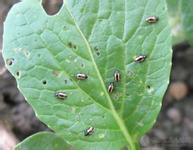Causes and Solutions of Peanut empty Shell
Peanut is planted in many areas of our country, which is an important oil and economic crop, which brings considerable economic benefits to growers, but the phenomenon of empty shell often occurs when planting, which seriously affects the yield of peanut and brings economic losses. So what is the cause of the peanut shell? How to solve it? The following editor will solve this problem for everyone.

1. Variety reasons
The variety of peanut is also one of the reasons for its empty shell. generally, the peanut with empty shell is the variety of large peanut series, these varieties have large and heavy grains when planting, and the corresponding nutrients are more, so it is easy to cause empty shell. However, the pearl series of small peanuts seldom have the phenomenon of empty shell.
Solution: when planting, try to choose the varieties of small peanut pearl series, if it is a big peanut variety, reduce the planting density, strengthen fertilizer and water management, and ensure that there are enough nutrients for its growth.
2. Calcium deficiency
The main cause of peanut empty shell is calcium deficiency. If peanut lacks calcium during pod development, it will affect grain development and form empty shell. Calcium deficiency is sometimes caused by many factors, including soil and man-made management.
Soil: the soil is too barren, lack of fertility, and does not apply calcium fertilizer or organic fertilizer, resulting in insufficient income and expenditure, resulting in calcium deficiency, as well as acidic soils such as latosol and yellow brown soil, with low activity of calcium content and easy to lack calcium.
Climate: when planting in a high-temperature and rainy climate, the calcium in the soil will be lost very quickly, and the lack of water, drought or waterlogging in the soil will also affect the absorption of calcium by the root system.
Improper fertilization: in order to pursue yield, some farmers apply nitrogen fertilizer blindly, while ignoring the application of other fertility, resulting in too much nitrogen in the soil, leading to excessive growth of peanut plants, while the underground parts cause empty shells due to lack of nutrition. In addition, lack of boron will also cause empty shell of peanut, and excessive application of potassium fertilizer will also cause empty shell.
3. prevention and control measures
Calcium deficiency requires timely fertilization and supplement of calcium. Organic fertilizer can be applied to the soil, 3000-4000 kg per mu to ensure a comprehensive supply of nutrition. Calcium superphosphate is applied when topdressing, which contains not only phosphorus, but also calcium, which can increase the two nutrients of calcium and phosphorus in the soil. Generally, 30 kg per mu is used as base fertilizer, and 10-20 kg per mu is applied in the later stage. During flowering and podding, one foliar spraying of boron fertilizer was carried out to promote flowering, increase grain weight and increase yield. Potash fertilizer should be applied deeply to prevent excessive potassium in the fruiting layer and affect the absorption of calcium, which can be carried out in the middle tillage and deep ploughing.
The above are the reasons and solutions to the empty peanut shell. I hope it can help you. If you want to know more about peanut planting, please follow us.
- Prev

Prevention and control of striped jumping beetle of rapeseed
In recent years, yellow striped flea beetle has become another major pest in the seedling stage of rape in Hongta district. The insect can not only fly but also jump, so it is difficult to catch on the leaves. When disturbed, it jumps to the ground or the ditch near the field, and then flies back to the leaves to feed, often clustered on the back of the leaves to feed.
- Next

Field Management of Rice in Summer
Field Management of Rice in Summer
Related
- The first cup of black tea in spring, the flavor and history of tea gardens in Kenya, Africa
- The computer can not only choose potatoes, but also grow tea rice. AI will grow winter oolong tea champion.
- It is not only the inflated tea bitten by insects, but also engraved with the four seasons tea in Beipu.
- The Oriental Beauty Tea Festival in Zhuxian County takes the stage at the weekend to experience the plus-size feast of oil tea.
- & quot; Oriental Beauty Tea & Exploration of Emei in Hsinchu, the hometown of quot;
- The new variety of strawberry "Tainong 1" dessert is the first choice with mellow aroma. Crimson gorgeous
- History of Tea in Taiwan: from Wild Inner Mountain to Export Tea Garden
- Two types of Taiwan Oriental Beauty Black Tea won the British three-Star Award for Childhood Tea Xiang Zhang Jiaqi changed from pilot to champion tea maker.
- Banana species and varieties: the planting history of Taiwan Xianren banana and dwarf banana is long, is banana disease resistant?
- Coffee planting Technology: Qianjie Coffee from Seedling to harvesting

